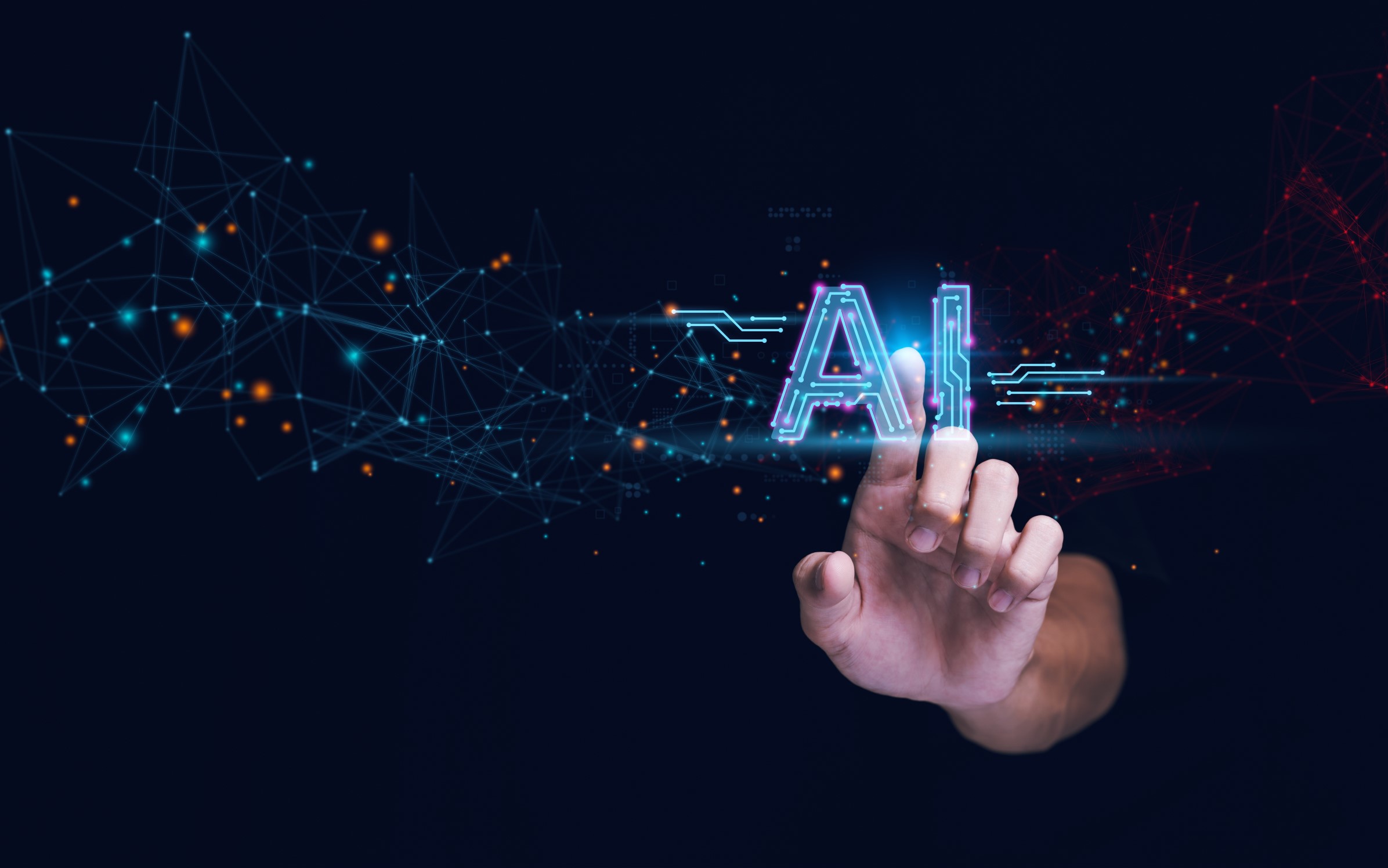
Subscribe to our free Newsletter
💌 Stay ahead with AI and receive:
✅ Access our Free Community and join 400K+ professionals learning AI
✅ 35% Discount for ChatNode
Welcome to The AI Report!
.png)

Humanity AI: Human-Centric Solutions for 2025
Discover humanity AI solutions that transform artificial intelligence into human-centered technology. Ethical AI tools for better human experiences in 2025.


The artificial intelligence revolution has reached a turning point. While technology continues advancing at breakneck speed, a fundamental shift is happening in how we approach AI development and deployment. The focus is moving from pure technological capability to something far more meaningful: creating AI systems that truly serve humanity's best interests.
This transformation represents more than just a trending buzzword. It's a recognition that the most successful AI implementations of 2025 will be those that prioritize human values, preserve human agency, and enhance rather than replace human capabilities. As organizations grapple with the promise and perils of AI, the concept of humanity AI has emerged as a guiding principle for responsible innovation.
The data supports this shift. 91% of businesses globally are using AI in 2025, with 77% integrating it into workflows, while 92% of companies plan to increase investments in AI over the next three years. However, the most revealing trend is that organizations achieving sustainable success focus on augmenting rather than replacing human capabilities.
What Humanity AI Means in 2025: Beyond Technology to Human-Centered Innovation

Defining Humanity AI in the Modern Context
Humanity AI represents a fundamental reimagining of artificial intelligence's role in our lives. Rather than viewing AI as a replacement for human intelligence, this approach treats technology as a collaborative partner designed to augment human capabilities while respecting our values, rights, and diverse needs.
At its core, humanity AI prioritizes human well-being above all else. These systems are built with empathy, ethical alignment, and societal benefit as primary objectives. Unlike traditional AI development that often focuses solely on technical optimization, human-centric approaches consider the broader implications of technology on individuals and communities.
Leading AI ethics researcher Stuart Russell emphasizes that "we must realize systems that have objectives aligned with human values, not just those that optimize mathematical functions efficiently." This philosophy drives the modern definition, which encompasses AI systems that operate in harmony with human values, fostering authentic connections and meaningful interactions while addressing complex societal challenges in health, education, and equity by supporting rather than supplanting human decision-making.
What makes humanity AI particularly relevant in 2025 is its emphasis on preserving human agency. These systems adapt to people rather than forcing people to adapt to technology. They understand context, emotion, and intent, creating more natural and intuitive interactions that respect cultural diversity and individual preferences.
The Evolution from AI-First to Human-First Approaches
The journey from AI-first to human-first thinking reflects a maturation in our understanding of technology's role in society. Early AI development prioritized technological advancement and data-driven optimization, often treating human factors as secondary considerations. The results, while technically impressive, frequently created solutions that felt alien or disconnected from real human needs.
This trajectory has shifted dramatically toward human-first models that embed ethical frameworks, transparency, and inclusivity at the foundation of system design. The change represents more than surface-level adjustments; it requires fundamentally rethinking how AI systems are conceived, developed, and deployed.
Cathy O'Neil, author of Weapons of Math Destruction, warns that "algorithms are opinions embedded in code," and advocates that public scrutiny must become routine so that "the bias and hidden harms often encoded within AI cannot operate in silence or darkness." Her perspective reflects growing recognition that systemic, third-party audits of AI models will become standard practice by 2025.
Human-first approaches recognize that trust, interpretability, and the preservation of human judgment are essential, particularly in complex or high-stakes environments. AI adoption in the United States is highest among large organizations (over 5,000 workers: >50% adoption; over 10,000: >60%), yet many are discovering that technical capability alone doesn't guarantee successful outcomes.
The evolution includes embracing multidisciplinary perspectives that integrate insights from social sciences, humanities, and ethics into AI development. This shift reflects a growing appreciation that AI should function as an extension of human action, supporting rather than replacing human capabilities. Success depends on continuous feedback between humans and machines, creating systems that learn and adapt alongside their human partners.
Perhaps most importantly, this evolution emphasizes responsible innovation. Instead of asking merely "can we build this?" the human-first approach demands we also ask "should we build this?" and "how can we ensure this serves human flourishing?" This philosophical shift is reshaping entire industries and setting new standards for what constitutes successful AI deployment.
Core Principles of Human-Centric AI Solutions
Ethical AI Development and Implementation
Ethical AI development starts with recognizing that technology choices are moral choices. Every algorithm, every dataset, and every deployment decision carries implications for human welfare. The most effective human-centric AI systems are built on robust ethical frameworks that prioritize fairness, accountability, and respect for human rights throughout the entire development lifecycle.
Timnit Gebru argues that "the AI community must turn its attention to the present-day harms affecting marginalized groups—not only to hypothetical superintelligence risks." This perspective drives modern ethical AI requirements that include sophisticated mechanisms to identify and mitigate bias before it can cause harm. Development teams must ensure their systems act consistently with collective well-being and justice, not just narrow efficiency metrics.
The shift toward anticipatory AI ethics will move "beyond reactive approaches," calling for institutions to foresee and shape technological impacts rather than merely respond to harm after the fact. Recent research advocates for "epistemic humility and a well-defined technological horizon," meaning that leaders should plan within the bounds of what is foreseeable, and not make predictions based on hype or speculative AI futures.
Ongoing ethical oversight has become essential rather than optional. This includes multidisciplinary review processes, active stakeholder engagement, and continuous evaluation of AI impact on different communities. Organizations are learning that ethical considerations can't be bolted on after the fact; they must be integral to system architecture from day one.
The emphasis on proactive governance extends to clear guidelines for responsible data use, informed consent mechanisms, and robust redress procedures when systems cause unintended harm. Companies are discovering that ethical AI isn't just morally right—it's also good business, as consumers and partners increasingly demand transparency and accountability.
Privacy-First AI Systems

Privacy has evolved from a nice-to-have feature to a fundamental requirement for human-centric AI. Growing concern is evident in the data: 57% globally agree AI poses a significant privacy threat, while 61% of global respondents are wary about trusting AI systems. These statistics underscore why privacy-first design has become essential for building public trust.
Privacy-centric systems ensure individuals maintain meaningful control over their personal data through transparent policies and clear boundaries on usage. Advanced technologies like encryption, federated learning, and decentralized identity management are being deployed to protect sensitive information without sacrificing functionality.
The most successful implementations employ data minimization strategies, collecting only what's necessary and anonymizing information whenever possible. Secure storage protocols and robust access controls reduce exposure to breaches or misuse. Despite these concerns, 86% of organizations believe data privacy has a positive business impact, creating strong incentives for privacy-first approaches.
Users are being empowered with granular consent options, real-time visibility into data flows, and the ability to modify or delete their information at any time. The challenge lies in balancing the benefits of data-driven insights with the imperative to respect individual autonomy and confidentiality.
Organizations are learning that privacy-first systems aren't just about avoiding regulatory penalties. They're about building the foundation of trust necessary for long-term human-AI collaboration. When people feel their privacy is respected, they're more willing to engage with AI systems in ways that create mutual benefit.
Transparent and Explainable AI
Transparency forms the bedrock of trustworthy AI systems. Users, stakeholders, and regulatory bodies increasingly demand clear explanations of how AI systems make decisions and on what basis they operate. This requirement has moved beyond academic discussion to practical necessity as AI systems influence more aspects of daily life.
There is consensus that AI explainability will become a currency for innovation: both regulators and stakeholders will expect AI systems to provide transparent, understandable reasoning for their decisions. Explainability tools and interfaces are being developed to help non-technical users understand, interrogate, and trust AI outputs.
Models are increasingly designed with interpretability as a core requirement rather than an afterthought. This means choosing architectures and approaches that naturally provide insight into their decision-making processes, even if this sometimes means accepting slightly lower performance metrics in exchange for transparency.
Stuart Russell emphasizes that "the ability to audit and interpret AI decisions" is foundational for trustworthy, human-centric systems. Continuous monitoring and documentation of decision processes ensure accountability and facilitate auditability. Organizations are implementing systems that track not just what decisions were made, but why they were made and what factors influenced the outcome.
Open communication about AI limitations, potential risks, and areas of uncertainty has become a competitive advantage rather than a liability. Users who understand what AI can and cannot do are better positioned to use these tools effectively and maintain appropriate skepticism about their outputs.
Inclusive Design for Diverse Communities
Inclusive design ensures AI systems work for everyone, not just the demographics represented in development teams or initial user studies. This principle recognizes that technology designed by and for homogeneous groups often fails to serve diverse populations effectively, creating or exacerbating existing inequalities.
The challenge is substantial and well-documented. Nearly 70% of all detected bias exploits in large language models occurred in regional languages rather than English, highlighting how easily non-English-speaking populations can be left behind by AI systems. This underscores the importance of designing systems with global diversity in mind from the outset.
The most successful human-centric AI solutions are developed with input from a wide range of stakeholders, reflecting the needs and perspectives of diverse populations. This requires active outreach to communities that might otherwise be overlooked, including people with disabilities, different cultural backgrounds, varying levels of technical expertise, and diverse socioeconomic circumstances.
Removing barriers to access means considering not just technical accessibility but also economic, cultural, and linguistic barriers. AI systems must be usable by people who speak different languages, come from different cultural contexts, and have varying levels of digital literacy. This often requires significant customization and localization efforts that go beyond simple translation.
Ongoing engagement with communities ensures AI systems evolve in response to real-world feedback and changing needs. This isn't a one-time consultation process but a continuous relationship that helps systems stay relevant and respectful as they scale across different contexts.
Real-World Applications of Humanity AI in 2025
Healthcare: Personalized Treatment with Human Oversight

Healthcare represents one of the most promising applications of humanity AI, where the stakes are high and human judgment remains irreplaceable. Leading implementations demonstrate how artificial intelligence for humanity can enhance medical care while preserving the essential human elements of healing and compassion.
The sector shows remarkable adoption, with healthcare projected to see 90% of hospitals using AI for remote monitoring and early diagnosis by 2025. Recent case studies provide concrete evidence of both financial returns and human impact. Hackensack Meridian Health's clinical decision AI platform demonstrates this potential, achieving an 18% reduction in hospital readmission rates within six months and cutting average length of stay by 0.9 days for targeted conditions.
The financial impact is substantial. With implementation costs of approximately $2.3 million over twelve months, the system generated annual cost savings forecasted at over $5 million for the hospital network. More importantly, the human impact metrics showed that over 90% of clinical staff prefer the system, citing less time spent on paperwork and more time for direct patient care.
Mayo Clinic's partnership with IBM Watson Health exemplifies this human-centric approach. Their AI-powered tools analyze patient genetics, medical histories, and clinical studies to recommend individualized treatments, particularly in oncology. The system has led to improved patient outcomes and higher response rates, but critically, medical professionals retain ultimate decision-making authority.
HCA's "Cati" virtual AI assistant demonstrates another human-centric approach, designed to assist caregivers during shift changes and streamline continuity of care. By automating routine communication and flagging important updates, Cati allows human caregivers to focus more on patient interaction while keeping the care team responsible for actual decisions and interventions.
These implementations share key features: AI analyzes and synthesizes information at scale, presenting options or insights, but human professionals retain ultimate authority over actions and decisions. This augmented approach improves both efficacy and trust in high-stakes medical environments while ensuring that technology serves both medical excellence and compassionate care.
Education: AI Tutors That Enhance Human Learning
Educational AI represents a particularly human-centric application where artificial intelligence and humanity must work in perfect harmony. The goal isn't to replace teachers but to amplify their capabilities while providing personalized learning experiences that adapt to individual student needs.
AI-powered educational tools provide customized learning pathways that adjust to individual strengths, weaknesses, and learning styles. These systems can process vast amounts of educational data to identify patterns and suggest interventions, but they work most effectively when combined with human insight and empathy.
Intelligent tutoring systems support teachers by automating routine tasks like grading basic assignments and tracking student progress, freeing up valuable time for human mentorship, creativity, and emotional support. This division of labor allows educators to focus on what they do best—inspiring, encouraging, and providing the kind of guidance that only humans can offer.
Real-time feedback and adaptive assessments help students understand their progress and identify areas for improvement. Interactive content and gamification elements foster deeper engagement, but the most effective systems maintain clear pathways for human intervention when students need additional support or encouragement.
Despite these promising developments, the opportunity remains largely untapped. AI adoption in education remains very low at just 1.5% in the US, with early pilots showing mixed results. This suggests significant room for growth as the technology matures and educational institutions develop better frameworks for human-AI collaboration.
The key to successful educational AI lies in preserving the irreplaceable human elements of teaching—empathy, encouragement, ethical guidance, and the ability to inspire curiosity and critical thinking. When AI serves these human capabilities rather than attempting to replace them, the results can be transformative for both students and educators.
Workplace Collaboration: AI as Digital Colleagues

The workplace transformation happening in 2025 represents a shift from viewing AI as a replacement threat to embracing it as a collaborative digital colleague. This approach focuses on leveraging complementary strengths where AI handles data-intensive tasks while humans focus on strategic, interpersonal, and creative activities.
The financial benefits are becoming clear. Companies report cutting over 3.5 hours of administrative work per employee per week through AI, and in leading use cases, businesses estimate ROI exceeding $5 for every $1 spent. These productivity gains free human workers to focus on higher-value activities that require creativity, empathy, and strategic thinking.
PA Consulting's overhaul of their sales operations using Microsoft 365 Copilot demonstrates this collaborative approach. The AI system automates administrative and support tasks, freeing consultants to focus on high-value, client-facing activities. Crucially, human consultants retain control over final client recommendations and strategies, leveraging AI insights while making all critical decisions themselves.
The data shows growing acceptance of this collaborative model. Currently, 31% of employees expect to be fully supported in their use of generative AI in three years, up from 29% at present, with moderate to significant support projected to reach 56%. Additionally, generative AI is used by 54% of employees in companies using AI in 2025, indicating rapid adoption of collaborative AI tools.
Digital colleagues assist with information retrieval, project management, and communication, enhancing productivity while reducing cognitive load. These systems can quickly synthesize large amounts of information, identify patterns, and suggest action items, but they work best when human users provide context, judgment, and strategic direction.
The most successful workplace AI implementations respect organizational culture, privacy concerns, and employee autonomy. They're designed to enhance human capabilities rather than monitor or control human behavior, creating an environment where people and AI can truly collaborate as partners.
Smart Cities: Technology Serving Community Needs
Smart city initiatives in 2025 exemplify how humanity AI can transform urban environments by prioritizing community well-being over pure technological efficiency. These systems optimize transportation, energy, safety, and public services while ensuring that technology serves residents rather than the other way around.
AI-powered infrastructure responds to real-time data, enabling adaptive management of resources and rapid response to emerging challenges. Traffic flow optimization, energy distribution, and emergency response systems can adjust automatically to changing conditions, but the most effective implementations maintain human oversight for strategic decisions and community priorities.
Smart city success depends on equitable access and participatory governance. The technology must benefit all residents, not just those with the resources or technical knowledge to take advantage of new systems. This requires careful attention to digital divides and ongoing community engagement to ensure services meet diverse needs.
Privacy, security, and transparency are embedded in citywide AI deployments to build public trust and accountability. Citizens need to understand how their data is being used and have confidence that smart city systems respect their rights and preferences. This often means implementing privacy-by-design principles and providing clear opt-out mechanisms for those who prefer not to participate.
Ongoing community engagement shapes the evolution of smart city technologies, ensuring they align with local priorities and values. The most successful initiatives involve residents in planning and decision-making processes, treating them as partners rather than passive beneficiaries of technological progress.
Regulatory activity has intensified globally, with OECD, EU, UN, and African Union launching responsible AI frameworks specifically for public sector and smart city contexts. This regulatory attention reflects the high stakes involved when AI systems affect entire communities and the importance of getting these implementations right.
Building Human-AI Collaborative Systems
Design Frameworks for Human-AI Partnership
Effective human-AI collaboration requires thoughtful design frameworks that recognize both the strengths and limitations of human and artificial intelligence. The most successful systems treat AI as a partner rather than a tool, creating interfaces and workflows that enable seamless cooperation between human intuition and machine capability.
AI talent augmentation—not just automation—is inevitable. In 2025, software developers, policymakers, and domain specialists are expected to be empowered with AI tools, but final authority and interpretive skills will remain human. This principle drives symbiotic AI design that focuses on appropriate transparency, progressive autonomy, and continuous feedback integration.
The Microsoft HAX (Human-AI Experiences) Toolkit provides comprehensive guidelines for creating intuitive AI interactions. This framework emphasizes behavior design principles that make AI systems predictable and understandable, reducing the learning curve for human users while maintaining system effectiveness.
Human-AI co-creation frameworks treat AI as an active participant in design ideation and decision-making rather than a passive automation tool. These approaches structure interactions in iterative cycles of proposal, critique, and revision, leveraging the creative capabilities of both humans and AI systems.
Participatory design and user-centered development guide the creation of tools that feel natural and empowering rather than alien or threatening. The most effective frameworks incorporate feedback loops that allow systems to evolve based on real-world usage patterns and changing human needs.
Decision-Making Models That Preserve Human Agency

Preserving human agency in AI-assisted decision-making requires careful attention to who makes what decisions and under what circumstances. The most effective models maintain human authority over significant choices while leveraging AI capabilities for information processing and option generation.
Cathy O'Neil emphasizes that "as AI becomes more embedded in daily life, the algorithmic power must be met with equal accountability… Algorithms need auditors." This perspective drives hybrid approaches that combine automated insights with human review, allowing for override or modification based on contextual knowledge that AI systems might lack.
Japanese healthcare startup Ubie's AI-powered physician assistance tools exemplify this approach. Their models suggest diagnostic hypotheses or potential care pathways, but clinicians always review, validate, and decide on diagnoses and treatments, preserving their professional agency while benefiting from AI's pattern-recognition capabilities.
The Pew Research Center found that while AI experts are far more positive than the public about AI's impact on work and society, a shared priority across both groups is "greater personal control of AI." This underscores the importance of systems that augment human judgment by providing evidence, options, and predictions without dictating outcomes.
Decision-making models emphasize transparency and traceability, ensuring that both AI recommendations and human decisions can be explained and justified to all stakeholders. This creates accountability mechanisms that protect against both AI errors and human biases while respecting human expertise and maintaining clear lines of authority.
Training AI to Understand Human Context and Emotions
Advanced AI systems increasingly incorporate emotional intelligence and contextual awareness to enable more natural and effective human-AI interactions. This capability goes beyond simple sentiment analysis to understanding subtle cues, cultural nuances, and individual preferences that shape human communication.
Context-aware algorithms enable AI systems to adapt their responses based on situational factors, user history, and environmental conditions. These systems can recognize when a user is frustrated, confused, or satisfied, adjusting their interaction style accordingly to provide more appropriate support.
Training for emotional intelligence requires diverse datasets that capture the full range of human expression across different cultures, languages, and contexts. The most effective approaches involve ongoing refinement based on real-world interactions and user feedback, allowing AI systems to continuously improve their understanding of human needs and preferences.
Technology experts project that 61% believe the change at the AI-human interface will be "deep and meaningful" or "fundamental and revolutionary" by 2035, emphasizing increased focus on developing uniquely human traits like creativity, decision-making, and innovation rather than simple task automation.
The challenge lies in training AI systems to recognize and respond appropriately to emotional cues without becoming manipulative or intrusive. The goal is to create AI that can provide empathetic support while respecting human autonomy and emotional boundaries.
Addressing the Challenges of Human-Centric AI
Balancing Automation with Human Control
Finding the right balance between automation efficiency and human control remains one of the most complex challenges in humanity AI implementation. Organizations must navigate between leveraging AI's capabilities to improve processes while ensuring humans retain meaningful oversight and decision-making authority.
The data reveals how early this journey remains for most organizations. Currently, just 1% of companies believe their AI practices are at maturity, indicating that most organizations are still learning how to achieve this balance effectively. This creates both challenges and opportunities for those willing to invest in thoughtful implementation approaches.
The integration of automation requires careful consideration of fail-safes, escalation protocols, and transparent reporting mechanisms. These systems must be designed so that humans can easily understand when automation is working correctly and quickly identify when intervention is necessary.
Organizations are learning to foster cultures of shared responsibility where the benefits of automation are balanced with clear accountability structures. This means training teams to work effectively alongside AI systems while maintaining critical thinking skills and domain expertise.
Regular assessment of automation's impact on roles, responsibilities, and outcomes helps ensure alignment with human values and organizational objectives. The most successful approaches involve ongoing dialogue between technical teams, end users, and leadership to continuously refine the human-AI partnership.
Overcoming Bias in AI Systems
Addressing bias in AI systems requires systematic approaches that go beyond good intentions to implement concrete technical and organizational measures. The scope of the challenge is significant: 86.1% of bias triggers in large language models require only a single input, not sophisticated adversarial queries, suggesting that bias can emerge from seemingly innocent interactions.
The growing awareness of these issues is reflected in reporting trends. 233 AI-related incidents were formally reported globally in 2024, representing a 56.4% year-over-year increase. This suggests that while awareness of bias issues is growing, the challenge of creating truly fair AI systems remains substantial.
Bias mitigation starts with diverse data sourcing and inclusive development teams that can identify potential issues early in the development process. This requires active effort to ensure datasets represent the full range of populations that will use the system, not just those who are easiest to reach or most similar to the development team.
Algorithmic fairness techniques help identify and correct for disparate impacts across different groups. These approaches involve testing systems across multiple demographic categories and adjusting algorithms to ensure equitable outcomes. However, technical solutions alone aren't sufficient; they must be combined with ongoing human oversight and community engagement.
Transparent communication about limitations and ongoing efforts to reduce bias helps build trust with users and stakeholders. Organizations are learning that acknowledging imperfections while demonstrating concrete steps toward improvement is more effective than claiming their systems are bias-free.
Managing the Fear of AI Displacement

Addressing widespread concerns about AI displacement requires honest communication, practical support, and a clear vision for human-AI collaboration rather than replacement. The complexity of public sentiment is captured in research showing that a plurality of experts (50%) anticipate AI-driven changes will bring both positive and negative effects in equal measure to "the essence of being human in the next decade."
Clear communication and education initiatives help demystify AI and highlight its role as a supportive tool rather than a replacement technology. This involves showing concrete examples of how AI enhances rather than eliminates human roles, making the benefits tangible and personally relevant.
Organizations are investing heavily in reskilling and upskilling programs to prepare workers for new roles alongside AI. These programs focus on developing uniquely human skills—creativity, empathy, critical thinking, and complex problem-solving—that complement rather than compete with AI capabilities.
Leadership plays a crucial role in fostering positive narratives around human-AI collaboration. The most effective approaches focus on opportunity, empowerment, and shared success rather than efficiency gains that might suggest human workers are expendable.
Evidence from successful implementations supports optimistic messaging. Case studies show that organizations implementing human-centric AI often see improvements in job satisfaction and employee engagement alongside productivity gains, suggesting that thoughtfully implemented AI can enhance rather than diminish human work experiences.
Ensuring Accessibility Across All Demographics
Creating truly accessible AI systems requires going beyond technical compliance to address economic, cultural, and linguistic barriers that can exclude significant portions of the population. This challenge is particularly acute given the global nature of AI deployment and the risk of creating or exacerbating digital divides.
The linguistic accessibility challenge is substantial and well-documented. Research shows that bias rates are much higher in regional languages compared to English, and nearly 70% of all detected bias exploits in large language models occurred in regional languages rather than English. This underscores the need for organizations to invest in localization efforts that go beyond simple translation to consider cultural context and local needs.
Universal design principles guide the development of AI systems that work for people with varying abilities, technical skills, and resources. This often requires multiple interface options, adaptive technologies, and careful attention to cognitive load and complexity.
Economic barriers to AI access require creative solutions, including partnerships with community organizations, government programs, and alternative business models that don't exclude lower-income populations. The goal is ensuring that AI benefits reach all segments of society, not just those who can afford premium services.
Ongoing user research and feedback loops help identify accessibility challenges that might not be obvious to developers or designers. This requires building relationships with advocacy groups and diverse communities that can provide ongoing guidance and feedback as systems evolve.
Implementation Strategies for Organizations
Assessment: Evaluating Your Current AI Readiness
Organizational AI readiness extends far beyond technical infrastructure to encompass culture, skills, governance, and ethical frameworks. The most successful implementations begin with honest assessments of current capabilities and gaps across all these dimensions.
Technical assessments examine data infrastructure, system integration capabilities, and security measures. However, equally important are evaluations of organizational culture, change management capabilities, and staff readiness to work alongside AI systems effectively.
Given the evolving regulatory landscape, ethical standards and privacy practices require careful evaluation. With 80.4% of U.S. local policymakers now supporting stricter data privacy rules, organizations must ensure their practices meet evolving standards. The trend shows U.S. federal agencies introduced 59 AI-related regulations in 2024, over double those in 2023, making regulatory compliance increasingly complex and important.
Stakeholder alignment assessment helps identify potential sources of resistance or support for AI initiatives. This includes understanding employee concerns, customer expectations, and partner requirements that might influence implementation approaches.
Readiness assessments should identify not just current capabilities but also learning capacity and adaptability. The AI landscape evolves rapidly, so organizations need the ability to adjust their approaches as technology and best practices continue to develop.
Planning: Creating a Human-Centric AI Roadmap
Strategic planning for humanity AI requires balancing ambitious goals with realistic timelines and resource constraints. The most effective roadmaps align AI initiatives with organizational values and human-centric principles rather than simply pursuing technological capabilities for their own sake.
Goal setting must encompass both technical performance metrics and human impact measures. Success criteria should include user satisfaction, ethical compliance, and societal benefit alongside traditional efficiency and productivity measures.
Stakeholder engagement and cross-functional collaboration are essential for creating roadmaps that actually work in practice. This means involving not just technical teams but also end users, customer service representatives, compliance officers, and community partners in the planning process.
Risk management and ethical safeguards must be integrated into roadmap planning rather than treated as afterthoughts. This includes identifying potential failure modes, establishing monitoring systems, and creating protocols for addressing unintended consequences.
The regulatory environment continues evolving rapidly, with frameworks emerging globally that emphasize transparency, accountability, and equitable access. Organizations must stay current with requirements across multiple jurisdictions while maintaining consistent human-centric principles across different markets.
Execution: Best Practices for Deployment
Successful deployment of human-centric AI systems requires careful attention to change management, user training, and iterative improvement based on real-world feedback. The most effective approaches start small and scale gradually based on lessons learned from initial implementations.
Concrete examples demonstrate the value of this approach. LAQO Insurance's digital assistant "Pavle" achieved results within four months, resolving 30% of customer queries autonomously while reducing response times by 45% and increasing customer satisfaction by 12 points. The implementation cost of approximately $750,000 generated estimated cost savings of over $300,000/year.
Employee training programs must go beyond technical instruction to include ethical considerations, bias awareness, and effective human-AI collaboration techniques. The goal is building confident, critical users who can leverage AI capabilities while maintaining appropriate oversight.
Transparent communication with all stakeholders helps build support and manage expectations throughout the deployment process. This includes regular updates on progress, honest acknowledgment of challenges, and clear explanations of how the system works and what safeguards are in place.
Continuous monitoring and feedback collection enable rapid identification and correction of issues before they become serious problems. This requires both technical monitoring systems and human feedback mechanisms that capture user experience and satisfaction.
Monitoring: Measuring Success and Human Impact
Measuring the success of humanity AI implementations requires metrics that capture both technical performance and human impact. Traditional efficiency measures remain important, but they must be balanced with indicators of user satisfaction, ethical compliance, and societal benefit.
The business case for human-centric approaches is increasingly clear. Organizations report that 95% saw significant return on investment from privacy-focused practices, indicating that human-centric approaches create measurable business value alongside ethical benefits.
Success metrics should include qualitative feedback alongside quantitative data to provide a complete picture of system impact. Groupama's virtual assistant achieved an 80% query resolution rate on first contact while increasing customer satisfaction by 14% and improving employee engagement by 13%. The system saved human agents about 10,000+ hours annually, translating to an estimated $400,000/year in indirect savings.
Regular auditing processes help ensure systems continue to operate as intended and align with evolving standards and expectations. This includes technical audits of system performance as well as ethical audits of outcomes and impacts on different user groups.
Long-term monitoring frameworks track not just immediate outcomes but also systemic changes in work patterns, user behavior, and organizational culture. The goal is understanding how AI integration affects the broader human ecosystem over time.
The Future of Humanity AI: Trends and Predictions

Emerging Technologies Enhancing Human-AI Collaboration
The technological landscape for human-AI collaboration continues evolving rapidly, with advances in natural language processing, emotional intelligence, and contextual awareness enabling richer and more intuitive interactions. These developments are making AI systems feel less like tools and more like collaborative partners.
Investment patterns support this trend. Generative AI investment reached $33.9 billion worldwide in 2024, up 18.7% from 2023, signaling strong market demand for human-centric solutions that can adapt and evolve with their users.
Integration of multimodal interfaces that combine voice, gesture, and visual interactions supports seamless collaboration across different environments and devices. Users can choose the interaction method that works best for their current context and preferences, making AI more accessible and natural to use.
Technologies like decentralized identity, blockchain, and edge computing are enhancing privacy, security, and user control over AI interactions. These advances address some of the fundamental trust issues that have limited AI adoption by giving users more agency over their data and digital interactions.
Continuous progress in adaptive learning systems enables AI to evolve alongside human users, responding dynamically to changing needs and preferences. Rather than being static tools that require human adaptation, these systems learn and adjust their behavior based on ongoing interaction patterns.
Regulatory Landscape and Policy Development
The regulatory environment for AI is evolving rapidly as policymakers grapple with balancing innovation with protection of human rights and societal interests. The trend is clearly toward more comprehensive oversight, with particular emphasis on transparency, accountability, and equitable access.
Stuart Russell argues that "human-centered AI requires continuous oversight, with intelligible goals and verifiable alignment to human preferences," reflecting the direction regulatory frameworks are taking. PwC forecasts that risk management and responsible AI will move from aspiration to requirement by 2025, with transparent, systematic controls and validation processes demanded by stakeholders even in the absence of formal regulation.
Regulatory activity has intensified globally, with OECD, EU, UN, and African Union launching responsible AI frameworks. This international collaboration suggests growing consensus around the need for standards that prioritize human welfare over pure technological advancement.
The emerging regulatory frameworks focus increasingly on safety, transparency, and accountability requirements for AI deployment. This includes mandatory disclosure of AI use to consumers, algorithmic auditing requirements, and clear accountability structures for AI-related decisions and outcomes.
Organizations investing in human-centric approaches now will be better positioned to meet future compliance requirements, while those focused solely on technical capability may face significant adaptation challenges as oversight increases.
Long-term Societal Implications
The widespread adoption of humanity AI has the potential to fundamentally transform how we work, learn, receive healthcare, and participate in governance. These changes could enhance quality of life significantly, but they also raise important questions about power, agency, and what it means to be human in an AI-augmented world.
Research suggests nuanced impacts ahead. A plurality of experts (50%) anticipate AI-driven changes will bring both positive and negative effects in equal measure to "the essence of being human in the next decade," highlighting the complexity of managing this transition thoughtfully.
Societal impacts include evolving definitions of work and value creation, new forms of human-AI collaboration, and shifting power dynamics between individuals, organizations, and technological systems. The distribution of AI benefits across different populations will likely influence social equity and opportunity structures.
The transformation also presents opportunities for addressing longstanding societal challenges like healthcare access, educational equity, and environmental sustainability. AI systems designed with human-centric principles could help create more just and sustainable societies if implemented thoughtfully.
Long-term success depends on sustained commitment to ethical principles, inclusivity, and the prioritization of human flourishing over pure technological advancement. This requires ongoing vigilance and adaptation as capabilities expand and new challenges emerge.
Getting Started with Humanity AI Solutions
Tools and Platforms Available in 2025
The ecosystem of human-centric AI tools and platforms has matured significantly, offering options that range from no-code development environments to specialized collaboration suites designed with privacy, transparency, and user control as primary features.
Anthropic Claude stands out as a conversational AI system specifically designed with safety-first and human-aligned approaches. Claude integrates ethical guidelines and reduces bias while enabling intuitive, context-aware interactions that make it ideal for sensitive applications requiring human oversight.
Crescendo.ai focuses specifically on human-centric customer support, augmenting support teams with empathetic AI messaging and automated satisfaction analytics. The platform helps organizations deliver personalized, empathetic customer engagement at scale while preserving human control over critical interactions. Their approach boosted CSAT by enabling analysis of 100% of interactions and providing actionable recommendations for customer service agents, reducing burnout while improving resolution rates.
Hugging Face Hub provides the premier open-source platform for natural language processing and AI experimentation. Its collaborative features and extensive model library empower both newcomers and experts to build human-centered solutions while maintaining transparency and community oversight.
Synthesia offers AI video generation with strong emphasis on human-centric design, enabling organizations to create content in 140+ languages while addressing diverse communication needs. The platform exemplifies how AI can enhance human creativity rather than replace it.
Building Internal Capabilities
Developing internal capabilities for humanity AI requires investment in workforce development that goes beyond technical training to include AI literacy, ethical awareness, and interdisciplinary collaboration skills. The goal is creating teams that can thoughtfully implement and oversee human-centric AI systems.
Toyota's use of Google Cloud's AI infrastructure to empower factory workforce demonstrates effective internal capability building. Their approach allowed employees to build and deploy machine learning models internally, improving operational efficiency while fostering a culture of continuous human-centric process improvement.
Cross-functional teams that include technical experts, domain specialists, ethicists, and user experience designers are essential for creating truly human-centric solutions. These teams must be empowered to make decisions that prioritize human values over pure technical optimization.
Ongoing learning initiatives help organizations stay current with rapidly evolving best practices and emerging challenges in human-centric AI. This includes both formal training programs and informal knowledge sharing that builds institutional wisdom about effective AI implementation.
Cultural change management is often more challenging than technical implementation but equally important for success. Organizations must foster environments where questioning AI outputs, advocating for human oversight, and prioritizing ethical considerations are valued and rewarded.
Finding the Right Partners and Vendors
Selecting partners for humanity AI initiatives requires evaluating alignment with human-centric values, ethical standards, and long-term vision rather than focusing solely on technical capabilities or cost considerations.
Due diligence should assess not just technical expertise but also transparency practices, ethical frameworks, and track records in responsible AI deployment. Partners who can't clearly explain their approaches to bias mitigation, privacy protection, and human oversight may not be suitable for human-centric initiatives.
HCA's partnership with Google Cloud for developing "Cati" illustrates effective collaboration where external technical expertise combines with internal healthcare knowledge to create solutions that prioritize patient and provider needs.
Collaborative relationships work better than traditional vendor-client arrangements for human-centric AI projects. The complexity and evolving nature of this field require partners who are willing to learn, adapt, and iterate based on real-world feedback and changing requirements.
Long-term partnership potential is crucial given the ongoing nature of AI system maintenance, improvement, and adaptation. Organizations need partners who will remain committed to human-centric principles as their AI systems evolve and scale over time.
The journey toward humanity AI represents more than a technological shift—it's a fundamental reimagining of how we want to live and work alongside intelligent systems. As we move forward into 2025 and beyond, the organizations that succeed will be those that recognize AI not as a replacement for human intelligence, but as a powerful amplifier of human potential.
The data supports this approach. With 92% of companies planning to increase AI investments over the next three years, the winners will be those who invest wisely in systems that truly serve human needs. Organizations achieving ROI exceeding $5 for every $1 spent on AI share a common approach: they prioritize transparency over black box solutions, collaboration over automation, and human flourishing over pure efficiency metrics.
The path forward requires courage to ask difficult questions, wisdom to learn from early implementations, and commitment to iterate based on real-world outcomes rather than theoretical promises. But for organizations willing to embrace human-centric principles, the potential rewards extend far beyond improved productivity to include stronger stakeholder trust, more resilient operations, and meaningful contribution to a better future for all.
The age of humanity AI has arrived. The question isn't whether to participate, but how to do so in ways that honor our highest values while unlocking unprecedented possibilities for human and artificial intelligence working together.


.png)
.png)
.png)
.png)
.png)
.png)
.png)
.png)
.png)
.png)
.png)
.png)
.png)
.png)
.png)
.png)
.png)






.png)





